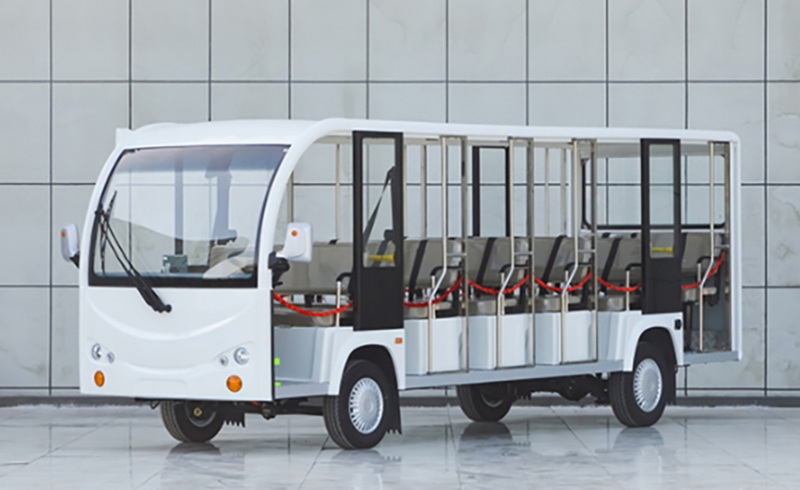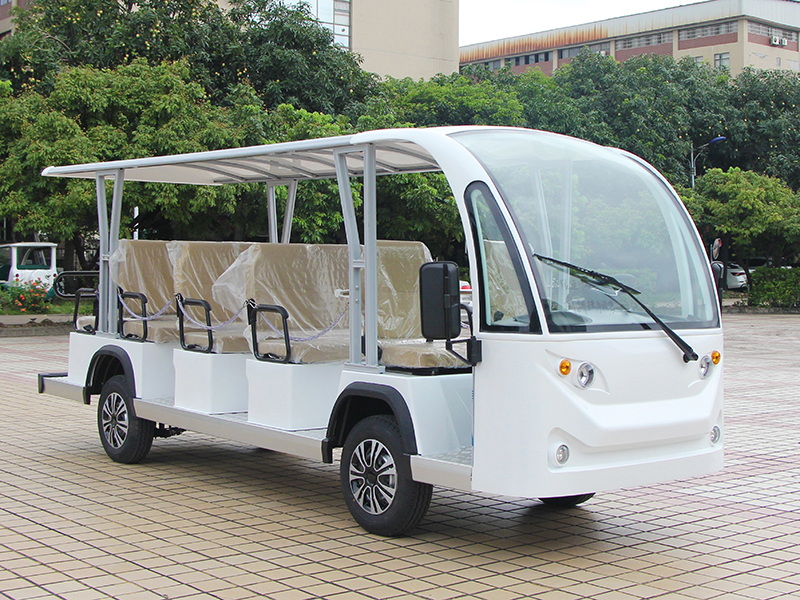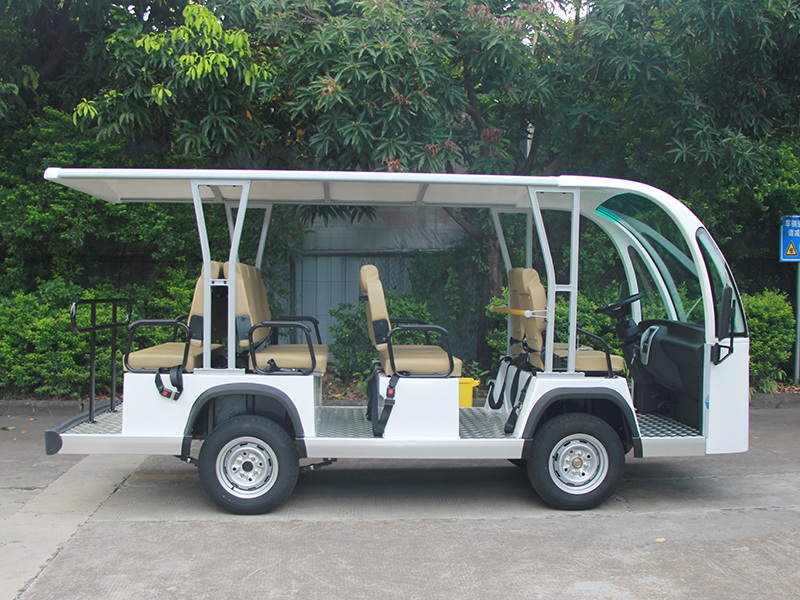Content Menu
● Introduction
● Challenges in Implementing Electric Sightseeing Carts Globally
>> 1. Charging Infrastructure Limitations
>> 2. Battery Technology and Range Constraints
>> 3. Supply Chain and Material Sourcing
>> 4. Regulatory and Policy Barriers
>> 5. Grid Capacity and Energy Management
>> 6. Interoperability and Standardization Issues
>> 7. Cost and Affordability
>> 8. Maintenance and Technical Expertise
>> 9. Cultural and Behavioral Acceptance
● Opportunities in Implementing Electric Sightseeing Carts Globally
>> 1. Environmental Sustainability and Emission Reduction
>> 2. Technological Advancements
>> 3. Government Incentives and Policy Support
>> 4. Enhanced Tourist Experience
>> 5. Partnerships and Collaborative Models
>> 6. Integration with Renewable Energy
>> 7. Market Expansion in Emerging Regions
>> 8. Customization and Versatility
>> 9. Data-Driven Operational Improvements
● Conclusion
● FAQ
>> 1. What are the main barriers to adopting electric sightseeing carts in developing countries?
>> 2. How do battery technologies impact the operation of electric sightseeing carts?
>> 3. What role do government incentives play in promoting electric sightseeing carts?
>> 4. How can electric sightseeing carts contribute to environmental sustainability?
>> 5. What technological innovations are shaping the future of electric sightseeing carts?
Electric sightseeing carts represent an innovative and sustainable solution for urban tourism and recreational transportation. As cities worldwide seek to reduce carbon emissions and enhance visitor experiences, electric sightseeing carts are gaining traction. However, their global implementation faces a complex landscape of challenges and opportunities that must be carefully navigated to maximize benefits.

Introduction
Electric sightseeing carts, often used in parks, historic sites, resorts, and urban centers, offer an eco-friendly alternative to traditional fuel-powered vehicles. They provide quiet, emission-free transportation that aligns with global sustainability goals. This article explores the multifaceted challenges and opportunities involved in deploying electric sightseeing carts on a global scale, focusing on technological, infrastructural, regulatory, economic, and social dimensions.
Challenges in Implementing Electric Sightseeing Carts Globally
1. Charging Infrastructure Limitations
One of the primary challenges is the uneven availability and distribution of charging infrastructure. While urban centers in developed countries may have adequate charging stations, rural and less developed areas often lack the necessary facilities, limiting the operational range and convenience of electric sightseeing carts. The expansion of charging networks requires significant investment and coordination between governments, private companies, and local stakeholders.
Moreover, the lack of fast-charging options can lead to downtime, reducing the efficiency of sightseeing operations. Tourist sites with high visitor turnover demand quick turnaround times for vehicles, and slow charging can disrupt schedules and reduce the number of trips per day.
2. Battery Technology and Range Constraints
Electric sightseeing carts rely heavily on battery technology. Although advancements are ongoing, current battery capacities can limit the distance and duration these carts can operate before needing a recharge. This limitation affects route planning and operational efficiency, especially in large tourist sites or sprawling urban areas. Additionally, battery degradation over time and the cost of replacement pose financial challenges for operators.
Extreme weather conditions also impact battery performance. In very cold or hot climates, battery efficiency drops, reducing range and increasing charging times. This variability complicates operational planning, especially in regions with harsh seasonal changes.
3. Supply Chain and Material Sourcing
The production of electric vehicles, including sightseeing carts, depends on critical minerals such as lithium, cobalt, and nickel. Geopolitical tensions and environmental concerns related to mining these materials create vulnerabilities in the supply chain, potentially leading to cost fluctuations and production delays. Sustainable sourcing and recycling initiatives are essential to mitigate these risks.
Additionally, the environmental and ethical issues surrounding mining-such as habitat destruction and labor rights abuses-have led to increased scrutiny. Manufacturers and governments are under pressure to ensure responsible sourcing, which can increase costs and complicate supply chains.
4. Regulatory and Policy Barriers
Global regulatory environments vary widely, with some countries lacking clear policies or incentives for electric vehicle adoption. In developing nations, weak regulatory frameworks and limited financial resources hinder the effectiveness of EV policies, making it difficult to scale electric sightseeing cart programs. Furthermore, the dependence on subsidies raises concerns about the long-term sustainability of these initiatives.
In some regions, bureaucratic hurdles and complex import regulations delay the introduction of electric carts. Additionally, standards for vehicle safety, emissions, and road use may not be harmonized, creating uncertainty for manufacturers and operators.
5. Grid Capacity and Energy Management
The increased use of electric vehicles places additional demand on local electrical grids. In many regions, especially those with aging infrastructure, the grid may struggle to handle peak charging loads, leading to voltage deviations and potential service disruptions. Upgrading grid infrastructure is costly and time-consuming but necessary to support widespread adoption.
Smart grid technologies and demand response systems can help balance loads, but their deployment is uneven. Without proper energy management, the environmental benefits of electric sightseeing carts may be offset by increased fossil fuel use in electricity generation during peak times.
6. Interoperability and Standardization Issues
A lack of standardized charging connectors and payment systems complicates the user experience and operational logistics for electric sightseeing carts, especially when deployed across different countries or regions. Efforts like the Combined Charging System (CCS) aim to address these issues but are not yet universally adopted.
This fragmentation can discourage tourists who may be unfamiliar with local systems and create additional costs for operators needing multiple types of chargers or payment platforms.

7. Cost and Affordability
Electric sightseeing carts and their associated infrastructure require significant upfront investment. While operational costs may be lower over time due to reduced fuel and maintenance expenses, the initial financial barrier can deter small operators and municipalities from adopting electric models. Affordability remains a critical factor in market penetration.
Additionally, the total cost of ownership includes battery replacement, insurance, and training for drivers and maintenance staff, which can strain budgets, especially for small businesses or public entities with limited funding.
8. Maintenance and Technical Expertise
Electric sightseeing carts require specialized maintenance knowledge, particularly related to battery systems and electric drivetrains. In many regions, there is a shortage of trained technicians, which can lead to increased downtime and higher repair costs. Developing local technical expertise is essential for the sustainable operation of electric fleets.
9. Cultural and Behavioral Acceptance
In some markets, tourists and operators may be resistant to adopting new technologies due to unfamiliarity or skepticism about electric vehicles' reliability and performance. Educating stakeholders and promoting the benefits of electric sightseeing carts are necessary to overcome cultural barriers and build trust.
Opportunities in Implementing Electric Sightseeing Carts Globally
1. Environmental Sustainability and Emission Reduction
Electric sightseeing carts produce zero tailpipe emissions, contributing to improved air quality and reduced greenhouse gas emissions in tourist areas. This aligns with global climate goals and local environmental regulations, making electric carts an attractive option for eco-conscious cities and operators.
By reducing noise pollution, electric carts also enhance the ambiance of natural parks, historic districts, and urban centers, preserving the visitor experience and protecting wildlife.
2. Technological Advancements
Ongoing innovations in battery technology, such as solid-state batteries, promise longer ranges and faster charging times, directly addressing current operational limitations. Improvements in electric drivetrains and energy management systems enhance efficiency and reliability, making electric sightseeing carts more viable and appealing.
Additionally, the integration of IoT (Internet of Things) technologies allows real-time monitoring of vehicle performance, battery health, and route optimization, improving fleet management and reducing operational costs.
3. Government Incentives and Policy Support
Many governments worldwide offer subsidies, tax incentives, and grants to encourage the adoption of electric vehicles, including sightseeing carts. These incentives reduce the financial burden on operators and accelerate market growth. Additionally, policies mandating low-emission zones and sustainable tourism practices create a favorable environment for electric cart deployment.
In some cities, electric sightseeing carts are integrated into broader smart city initiatives, benefiting from coordinated urban planning and funding that supports green transportation.
4. Enhanced Tourist Experience
Electric sightseeing carts can be designed with passenger comfort and accessibility in mind. Features such as open-air seating, panoramic windows, and flexible layouts improve the sightseeing experience, attracting more tourists and enhancing satisfaction. Quiet operation also allows for a more peaceful environment, beneficial in natural and historic settings.
Some operators incorporate augmented reality (AR) and audio guides into carts, providing interactive and educational tours that enrich visitor engagement.
5. Partnerships and Collaborative Models
Collaborations between municipalities, tour operators, and electric vehicle manufacturers facilitate the scaling of electric sightseeing cart programs. Joint efforts can focus on infrastructure development, shared charging stations, and integrated ticketing systems, improving efficiency and reducing costs.
Public-private partnerships (PPPs) are particularly effective in pooling resources and expertise, accelerating deployment and innovation.
6. Integration with Renewable Energy
Charging electric sightseeing carts using renewable energy sources like solar or wind power further enhances their environmental benefits. Some cities are piloting solar-powered charging stations, reducing reliance on fossil fuels and promoting sustainable energy ecosystems.
Microgrid solutions and energy storage systems enable off-grid or semi-autonomous charging facilities, expanding deployment possibilities in remote or underserved locations.
7. Market Expansion in Emerging Regions
Emerging markets in Asia, Africa, and Latin America represent significant growth opportunities. As these regions develop their tourism infrastructure and environmental policies, affordable electric sightseeing carts can meet the rising demand for sustainable transport options.
Local manufacturing and assembly can reduce costs and create jobs, supporting economic development alongside environmental goals.
8. Customization and Versatility
Electric sightseeing carts can be customized to suit different environments and customer needs-from rugged all-terrain models for safari parks to sleek, modern designs for urban tours. This versatility allows operators to tailor their offerings, enhancing market appeal.
Modular designs also facilitate upgrades and maintenance, extending vehicle lifespans and improving return on investment.
9. Data-Driven Operational Improvements
The use of telematics and data analytics enables operators to optimize routes, monitor vehicle health, and predict maintenance needs. This data-driven approach reduces downtime, improves safety, and enhances customer satisfaction.
Furthermore, data collected from tourist usage patterns can inform city planners and tourism authorities, supporting smarter infrastructure and service development.
Conclusion
The global implementation of electric sightseeing carts offers a promising pathway toward sustainable tourism and urban mobility. While significant challenges exist-ranging from infrastructure gaps and battery limitations to regulatory inconsistencies and cost barriers-these are being progressively addressed through technological innovation, policy support, and collaborative efforts. The opportunities for environmental benefits, enhanced tourist experiences, and market growth are substantial. With continued investment and strategic planning, electric sightseeing carts can become a cornerstone of eco-friendly tourism worldwide, contributing to cleaner cities and more enjoyable travel experiences.

FAQ
1. What are the main barriers to adopting electric sightseeing carts in developing countries?
The main barriers include weak regulatory frameworks, limited financial resources, lack of charging infrastructure, and affordability issues. These factors hinder effective policy implementation and market growth in developing regions.
2. How do battery technologies impact the operation of electric sightseeing carts?
Battery capacity and charging speed directly affect the range and operational efficiency of electric sightseeing carts. Advances such as solid-state batteries promise longer ranges and faster charging, improving usability and reducing downtime.
3. What role do government incentives play in promoting electric sightseeing carts?
Government incentives like subsidies, tax breaks, and grants lower the initial investment cost for operators, making electric sightseeing carts more financially viable and accelerating adoption rates.
4. How can electric sightseeing carts contribute to environmental sustainability?
By producing zero tailpipe emissions, electric sightseeing carts reduce air pollution and greenhouse gas emissions in tourist areas, helping cities meet climate goals and improve local air quality.
5. What technological innovations are shaping the future of electric sightseeing carts?
Innovations include high-capacity batteries, faster charging systems, vehicle-to-grid integration, solar-powered charging stations, and autonomous charging technologies, all enhancing performance and sustainability.










































